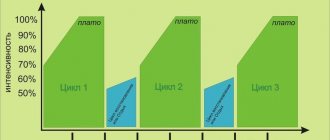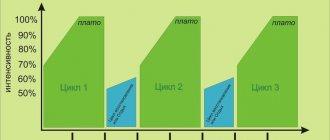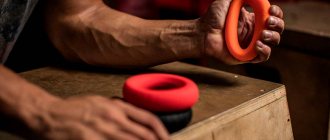Date of publication: 04/20/2017
until February 28
We're giving away RUR 1,000 for all services per visit in February More details All promotions
Regardless of age, weight or athletic ability, aerobic physical activity is very beneficial for you. Find out why—and get ready to move!
Aerobic exercise is a good way to strengthen the body
Regular aerobic exercise, such as walking, cycling or swimming, will help you live longer and healthier. Need motivation? Find out how aerobic exercise affects your heart, lungs and circulatory system. Then take action and get ready to reap the rewards of your efforts!
Features of aerobic exercise
To achieve results, exercises are used, the main source of energy for which is oxygen. That is, such training is aimed at strengthening all tissues of the body. They began to be used back in the seventies of the twentieth century, and in modern fitness they occupy an honorable place among the mandatory exercises for maintaining excellent shape and rapid weight loss.
Good to know: scientists have found that it is aerobic exercise that promotes fat burning and control the level of subcutaneous fat*.
Aerobic exercise is:
- all types of aerobics;
- cycling;
- skiing, skating and roller skating;
- swimming;
- running and exercise on a treadmill;
- race walking;
- dancing.
As you can see, the choice is truly impressive: if you wish, you can easily choose a suitable aerobic activity that will not only help keep your body in good shape, but will also bring real pleasure.
Energy sources
Muscle fibers require a huge supply of energy to perform any movement.
Regarding the task of training, the body may need the following types of energy sources for muscle nutrition:
- Adenosine triphosphate . It is a nucleotide found in the cells of a living organism. It performs 2 functions, namely: transportation and energy storage. For 3 sec. The nucleotide is used by the body to achieve maximum force in muscle fibers. Energy is released by splitting the phosphate component of ATP into 3 molecules.
- Anaerobic glycolysis. It is considered a chemical process that consists of enzymatic reactions. Their result is the breakdown of glucose into pyruvate and the production of energy. This process helps the athlete’s muscles begin to work with great effort for about 2 minutes.
- Aerobic glycolysis . It has a similar function as anaerobic. However, it occurs when a huge amount of oxygen is involved. This process provides the maximum muscle effort required by the athlete. The reproducible amount of energy is calculated for approximately 2 minutes. active physical training.
- Creatine phosphate . It is an organic compound that is located in nerve tissues, myocardium and skeletal muscles. Mainly involved in the process of power loads to activate energy. The permissible volume of the substance will be enough for approximately 20 seconds. strength training. Then the body takes other energy sources.
Anaerobic loading is the process by which both pyruvate and lactate are produced . Similar components appear during aerobic training. For a long time, lactate was considered a by-product of glucose breakdown.
However, today lactational compounds as glycogen gradually accumulate in the liver. The latter is used by muscles to release glucose. Therefore, lactate is indispensable during the period of restoration of energy balance in the body.
Benefits of Aerobic Exercise
Why do all trainers necessarily recommend alternating different types of loads and not forgetting about “oxygen training”? The fact is that aerobic exercise can bring maximum benefits:
- increase endurance;
- reduce the risk of developing cardiovascular diseases;
- remove waste and toxins from the body;
- prevent the development of diabetes and get rid of insulin resistance;
- strengthen bone tissue;
- improve your emotional state and effectively deal with stress;
- improve sleep quality, get rid of insomnia.
And while performing such exercises, calories are consumed well, which starts the fat burning process. As a result, the body loses excess weight faster.
Interesting fact: Arnold Schwarzenegger is a big fan of aerobic exercise, thanks to whom it has become incredibly popular among professional bodybuilders.**
How to develop it correctly?
So, we figured out that the level of anaerobic endurance is determined by characteristics associated with the efficiency of glycogen oxidation and the size of the glycogen depot itself in muscle tissue. How to properly develop anaerobic endurance under normal conditions? It's simple - you need intense anaerobic exercise, which will constantly increase. To do this you need:
- Maintain the desired intensity in the weights used, which will engage all muscle structures in the body.
- Constantly increase your training volume.
Unfortunately, the development of anaerobic endurance is in no way related to either the development of strength or the development of muscle volume. This is a purely energy-based workout that increases both efficiency and glycogen storage size.
© mtoome — depositphotos.com
Is there a classical approach that allows you to most effectively tune the energy systems in the body? Yes, this is not a favorite pumping for many. Why is pumping used to develop anaerobic endurance?
- Pumping clogs muscle tissue with blood, which reduces oxygen availability due to insufficient blood outflow.
- Pumping physically expands the glycogen depot by stretching the corresponding intermuscular tissue.
- Pumping with a constant progression of weight loads is the only training method that loads all layers of muscle tissue for a sufficient period of time.
Pumping training is a long and high-intensity training. It can include both individual strength complexes performed in several rounds, and a simple load on pumping blood into the muscle.
The optimal load for developing strength endurance is the range of repetitions from 30 to 50. With a higher number of repetitions, the body rebuilds its systems in such a way as to fully deliver oxygen, and this, in turn, trains not anaerobic, but aerobic endurance of the CrossFit athlete.
How it works?
During the first twenty minutes of performing any aerobic exercise, the glycogen received by the body throughout the day is quickly burned. And only half an hour after the start of the workout, proteins and fats begin to be consumed. If the workout takes at least forty minutes, then it is not in vain: the ongoing fat burning process continues for another two hours. However, in order for aerobic exercise to help you lose weight faster, you will have to adjust your eating habits:
- give up fast food, store-bought sweets and store-bought concentrated juices;
- reduce the amount of sugar in your diet;
- monitor the balance of proteins, fats and carbohydrates;
- eat more fiber;
- maintain water-salt balance.
If you feel hungry after a workout, you can drink natural yogurt or a glass of Herbalife Nutrition protein shake. These foods will not affect the positive effect, but foods rich in carbohydrates will stop the fat burning process.
Types of workouts
There are almost no pure anaerobic and aerobic training in sports . They are quite difficult to separate from each other, since anaerobic exercise is almost 15 seconds later. becomes aerobic.
It is recommended to perform anaerobic and aerobic exercises in a comprehensive manner. But only if there are no contraindications. This is necessary in order to get a positive result in losing weight, strengthening the heart, blood vessels and muscles. Combining 2 types of training is allowed in different ways. However, basic principles must be followed.
The following options are available:
- a set of classes with an emphasis on aerobic exercises;
- a complex of sports training that focuses on anaerobic training.
In the first option, exercises make it possible to increase the healing effect and also lose body weight. Strength training is added to aerobic training.
Such training can have several program options. The most common is considered to be completed within 40 minutes. aerobic exercises, which gradually change to strength training. The latter take approximately 20 minutes.
However, this type of training is considered ineffective and quite dangerous for muscle fibers. The best option is to perform separate anaerobic and aerobic training on different days. As a result, the muscles will not be overloaded, which will allow you to achieve the desired effect.
Example of anaerobic and aerobic exercise
Complex classes that focus exclusively on anaerobic training can have several types:
- A 15-minute performance of aerobic exercise acts as a warm-up stage before anaerobic training;
- conducting oxygen-free and oxygen classes on different days according to a previously drawn up schedule;
- At the end of the strength training, 20 minutes of aerobic exercise begins.
To improve health, build muscle, tighten the body and stay in constant tone, it is recommended to combine 2 types of training . At the same time, they must be correctly composed so that after playing sports you receive not harm, but benefit.
Recommendations for combining different types of training:
- It is advisable to perform classes in the evening from approximately 17.00 to 20.00. This period is considered the most optimal for sports.
- It is necessary to constantly monitor your well-being. If you can’t fully recover between visits to the gym, you need to stop doing cardio for a while. It is undesirable to subject the body to overtraining.
- You should adhere to sports nutrition. The pre-workout complex will allow you to perform normal strength and cardio exercises. Supplements that contain protein will allow you to recover and burn subcutaneous fat in a short period of time.
Features of anaerobic load
These are intense and short-term exercises with maximum muscle tension. During such training, the body receives virtually no oxygen, resulting in an increase in the amount of energy consumed. The exercises are performed quickly, in several short approaches. Such training includes:
- sprint running;
- fast cycling;
- powerlifting;
- body-building;
- all types of strength training;
- exercises on sports equipment.
In this case, all exercises alternate with short breaks, which allow the body to replenish the lack of oxygen. Such workouts help you quickly get rid of excess weight, disperse congestion, pump up muscles and achieve a beautiful figure relief. However, excessive overload is very dangerous and can cause problems with the respiratory system or cardiovascular system. That is why anaerobic exercise must be performed under the close supervision of a trainer.
Where does the energy come from?
The body's source of energy is a high-energy chemical called adenosine triphosphate, or ATP. When muscles work, ATP breaks down into adenosine phosphate or ADP, releasing energy. ATP reserves in the muscles are enough for only a few seconds of work. To replenish ATP reserves, muscles have energy systems: aerobic (oxygen) and anaerobic (lactate and phosphate). They restore ATP from its breakdown product ADP, and the body continues to function. Depending on what mechanism of energy production operates during physical activity, training is divided into aerobic and anaerobic.
During aerobic exercise, there is enough oxygen for metabolism. When anaerobic - there is not enough, acidification occurs. Aerobic exercise can also be of varying intensity; the bulk of training takes place in this range. Aerobic exercise creates the basis for the development of anaerobic exercise. It is important to know the moment where aerobic exercise turns into anaerobic exercise - the lactate threshold point or LTP.
Aerobic exercise develops overall endurance and is therefore important for long-distance runners. Anaerobic exercise is important for sprinters. However, in any sport, focusing on one type of training is ineffective and can lead to overtraining, so it is necessary to alternate the load.
Source: Axel Brunst on Unsplash
The benefits of anaerobic exercise
With the correct implementation of such training, you can achieve excellent results:
- develop endurance;
- get high strength indicators;
- speed up the fat burning process due to large calorie losses during exercise;
- strengthen and enlarge muscles;
- achieve a beautiful relief;
- correct posture and strengthen the musculoskeletal system;
- increase the level of immunity;
- reduce the risks of diabetes;
- increase body tone and get rid of constant fatigue.
For best results, it is recommended to combine anaerobic exercise with proper nutrition. For athletes who choose this method of gaining muscle mass, a diet with an increased amount of protein will be optimal.
Interesting fact: the effect of anaerobic training lasts for thirty-six hours, when metabolic processes continue to be active in the body, promoting fat burning and muscle growth.***
Types of aerobic training
Aerobic training is a long-term, low-intensity endurance exercise. The pulse lies within 60-85% of the maximum heart rate, but the main range is 70-80%. Aerobic training varies in intensity level:
- Intense . These are interval workouts consisting of a series of short accelerations with intermediate recovery. During acceleration, the heart rate can reach 85-90% of the maximum heart rate. This is a transition zone between aerobic and anaerobic training, so there may be a slight increase in lactate levels.
- Intermediate . These are long runs of moderate intensity or cycling, the heart rate is within 80-85% of the maximum heart rate.
- Extensive . These are long continuous workouts at a heart rate of 70-80% of the maximum heart rate: running at a calm pace, swimming. During such training, energy is obtained through the oxidation of fats, which allows you to save carbohydrates and maintain performance longer. This type also includes recovery training, where the heart rate should be below 70% of the maximum heart rate.
Read: Pulse when running: pulse zones, how to lower heart rate, video
How it works?
Loads of this type are effective when certain exercises are performed correctly and regularly. Two main factors are involved in the muscle development mechanism.
Anaerobic glycolysis.
During the exercise, the muscles consume their entire supply of oxygen: this is enough for a short-term load lasting no more than twelve seconds. After this, the body begins to consume oxygen, and the load turns into aerobic. However, the entire effect of training rests on glycolysis. In order for a person to perform physical exercise, energy is needed, and the body receives it from the ATP molecule, which is found, among other things, in muscles.
Anaerobic threshold.
This is an indicator of the intensity of the exercise, as a result of which a certain amount of lactic acid exceeds the level of its neutralization. Heart rate measurement can be used to measure this threshold. This will allow you to identify the rhythm of training during which the fat burning process will be most active.
Where do muscles get energy from?
Let's not dive into chemical and biological terms. Let's compare a person with a machine and understand where the muscles get their energy.
To keep the wheels spinning, you need gasoline. It burns out in the engine. For arms and legs to work, you need an ATP molecule. It “burns” in the muscles.
Adenosine triphosphoric acid or adenosine triphosphate (abbreviated as ATP) is a universal source of energy for all biochemical processes, including muscle function.
When a muscle contracts, the adenosine triphosphate molecule breaks down into smaller components. The breakdown of ATP is accompanied by the release of heat and energy. It turns out that adenosine triphosphate “burns” and gives us strength.
Adenosine triphosphoric acid is a kind of fuel for the body.
To make the car go faster, we press the gas pedal. Thus, we increase the amount of gasoline flowing from the gas tank to the engine.
Muscles work the same way. To run a cross-country race or lift a weight, you need many, many ATP molecules. Where can I get them? That's right - press on the gas pedal, speed up your metabolism.
Anaerobic and aerobic respiration
During training, both options for obtaining oxygen can be used. During aerobic exercise, it is breathing that helps to properly expend energy. Oxygen oxidizes carbohydrates, the lungs actively process this gas and saturate all tissues of the body. As a result, the respiratory system becomes stronger and body weight decreases. What is the difference between anaerobic exercise? To perform exercises, oxygen is not needed: the role of an oxidizing agent is played by substances contained in tissues. That is, the body actually breathes at the cellular level. At the same time, you need to understand that using only one type of load is not an entirely correct solution. If we are talking about training for the sake of rapid weight loss, working out muscles and obtaining beautiful relief, then anaerobic and aerobic techniques must be alternated. Your personal trainer will tell you exactly how. At least for this, it’s worth visiting the gym several times and understanding how your body works under certain types of load.
How does our body respond to aerobic exercise?
During aerobic exercise, you repeatedly tense the large muscles of your arms, legs, and hips. You will very quickly notice how your body reacts to this.
You will begin to breathe faster and deeper. This will increase the amount of oxygen in your blood. Your heart will start beating faster; this will increase blood flow to your muscles and then back to your lungs.
Your capillaries (the smallest blood vessels) will dilate to deliver more oxygen to your muscles and remove all unnecessary waste products such as carbon dioxide and lactic acid.
Your body will even release endorphins - natural painkillers that will noticeably improve your well-being.
Regardless of age, weight or athletic ability, aerobic physical activity is very beneficial for you. As your body adapts to regular aerobic exercise, you will become stronger and your fitness will improve.
Here are 10 ways aerobic exercise will help you feel better and get the most out of life.
Aerobic load:
1. Will not give extra pounds a chance
. When combined with a proper diet, aerobic exercise can help you lose extra pounds and maintain a healthy weight.
2. Will increase your endurance
. When you first start exercising regularly, you may feel tired, but after a while your endurance will increase and the fatigue will go away.
3. Prevents viral diseases
. Aerobic exercise activates your immune system. This will make you less susceptible to viral diseases such as colds and flu.
4. Reduces the risk of serious illness
. Aerobic exercise reduces the risk of various diseases, including obesity, heart attack, hypertension, type II diabetes, metabolic syndrome, stroke and even some types of cancer. High impact aerobic exercise on the legs, such as walking, also reduces the risk of osteoporosis.
5. Helps control chronic diseases
. Aerobic exercise lowers blood pressure and blood sugar levels. If you suffer from coronary heart disease, physical activity will help you control your condition.
6. Strengthens your heart
. A strong heart does not need to beat too fast. Additionally, a strong heart pumps blood more efficiently, which improves blood flow throughout the body.
7. Cleanses your blood vessels
. Aerobic exercise increases the content of high-density lipoproteins (HDL) in the blood - the so-called. “good” cholesterol – and lowers the level of low-density lipoprotein (LDL) – “bad” cholesterol. This reduces the risk of plaque formation in your blood vessels.
8. Improves your mood
. Aerobic exercise can ease the severity of depression, reduce anxiety and tension, and help you relax.
9. Allows you to remain active regardless of age
. Exercise keeps your muscles strong, which will help you stay active as you get older. Additionally, aerobic exercise makes your mind sharper. Research has shown that regular physical activity improves memory, thinking and intelligence (cognitive function) in both older and younger people. It is suggested that regular exercise may even prevent the development of dementia.
10. Will increase your life expectancy
. Research shows that people who regularly engage in aerobic exercise live longer than those who are not active.
A combination of aerobic and anaerobic exercise
You need to understand that there is no single type of training in its pure form. As we said above, after a maximum of 12 seconds of execution, the exercise turns from anaerobic to aerobic. To achieve maximum effect in training, it is better to choose the optimal set of exercises. However, before starting serious loads, you need to make sure that there are no contraindications:
- diseases of the cardiovascular system;
- gastrointestinal diseases;
- disorders of the kidneys and liver;
- chronic diseases in a state of relapse.
If you are unsure whether an exercise is right for you, it is best to consult your doctor first and then tell your trainer about it. If there are no contraindications, you can choose a program that focuses on aerobic or anaerobic exercise. In the first case, you will be able to lose excess weight faster and strengthen your body. In the second - to achieve a beautiful muscle relief.
Cardio load
Cardio exercise is a type of physical activity that affects the heart rate and increases the contractions of the heart muscle . The main benefit of these trainings is that the heart is strengthened and its function is stabilized.
A healthy and strong heart improves a person’s well-being. If there are any problems with this organ, a general deterioration in the body’s condition immediately occurs. Improvement of the body occurs when the heart rate increases, which can be achieved through cardio exercise. However, it is highly not recommended to load the heart muscle too intensely.
The main guideline when performing such training is the individual condition of the person, which also requires the selection of various individual programs. Otherwise, the body may receive a very high load, which will lead to dire consequences in the future.
When choosing an individual load level, it is necessary to take into account fitness, pressure and pulse when performing exercises, since the heart muscle can contract both slightly and extremely.
A gradual increase in load can be tolerated by a person who regularly plays sports without any problems. Those in poor health and older people should give preference to light exercise.
Various cardio exercises are combined with aerobic ones:
| Type of occupation | Features of the event |
| Run | It is considered a popular type of cardio exercise. At the stage of this exercise, most of the muscles are loaded, so there are a number of contraindications. For example, you should refuse to perform the exercise and consult a doctor in case of sore joints or spine, as well as in the presence of heart pathologies. The specialist will give some recommendations that will allow you to conduct such classes. |
| Cycling | They influence the strengthening of the heart, various muscle groups, and also affect weight loss in general. An analogue can be an exercise bike. |
| Dancing | The effect is similar to that of working out in the gym. Dancing increases your heart rate, which has a positive effect on the volume of your muscles and heart. In addition, the body acquires plasticity, elegance and grace. |
| Walking | The training is suitable for beginners, since it is advisable to start playing sports with intense walking. The pace should be increased gradually, because high loads are very dangerous to health. |
Cardio exercise can improve your health and also make your body slim. To obtain the required result, classes must be carried out at least 4 - 5 times every 7 days.
Anaerobic and aerobic exercise is widely in demand by people who lead an active lifestyle. The first type is training that is aimed at building muscles, the second type is focused more on strengthening the cardiovascular system. To obtain the maximum and effective effect, you need to combine 2 types of training, as well as take into account personal capabilities.
Contraindications to exercise
In addition to the above list, there are a number of prohibitions. For example, anaerobic exercise is not suitable for beginner athletes. In this case, the trainer draws up an individual training program, which gradually introduces complex, intense exercises on simulators. In addition, anaerobic exercise is strictly contraindicated for pregnant women and people who have recently undergone surgery. Aerobic exercises have a number of differences here too: expectant mothers, on the contrary, are advised to regularly walk and swim. You should check with your doctor about the possibility of resorting to other loads. At the same time, anaerobic exercises are contraindicated during exacerbations of respiratory diseases and in the presence of varicose veins, as well as during rehabilitation after surgical interventions. Remember that ignoring doctors' recommendations does more harm than good. It is worth returning to previous loads after injuries and illnesses gradually.
Types of anaerobic training
Anaerobic training is short-term, high-intensity exercise. The pulse lies within 85-100% of the maximum heart rate. Anaerobic training includes: strength exercises, shuttle running, long jumps, long accelerations, intervals, training in the mountains.
Do you like our project? Support us on Patreon or choose another way to support the project. Even a small help is a big contribution to our business.
Subscribe to us on Instagram, Telegram, YandexZen and Vkontakte.
Diet
No workout will give the desired result if you don’t change your usual diet. What does aerobic or anaerobic exercise diet mean?
- Refusal of fast food, excessively fried, fatty and sweet foods.
- Increasing fiber in your diet: eat fresh vegetables and fruits, preferably with minimal heat treatment.
- Consumption of large amounts of proteins: meat, fish, nuts, dairy products.
- Maintaining water-salt balance: you need to drink at least one and a half liters of clean water daily.
In addition, dietary supplements can be used to increase the body's endurance and maintain overall tone. For example, Herbalife Nutrition's Guarana-based NRG* tablets can help boost your energy levels. To recover after a workout, you can take a Formula 1 protein shake. A large amount of protein will saturate the body and contribute to the fat burning process.
How aerobic and strength exercises help you lose weight
We figured out how the body burns calories under the influence of aerobic and anaerobic exercise. As a bonus, let’s say that fat will “go away” after training.
The body needs to restore energy balance. Therefore, it continues to break down fat cells. The weight loss process can be extended for another 2 hours. After aerobic exercise, do not eat fatty and carbohydrate foods.
Strength training gives you even more options for losing weight. Recall that the goal of anaerobic exercise is to load the muscles.
After training, the body intensively “feeds” the overworked muscles. Muscles are growing. The growth of muscle tissue entails additional energy consumption.
Therefore, bodybuilders lean on protein foods. Protein, as you know, is not an energy drink. And the body has to “burn” fat tissue. This process lasts more than 12 hours.
Start at low heart rate
You won’t be able to achieve great results right away and you just have to come to terms with it. Start gradually, almost step by step. Even if your muscles are able to take you to high speed, your heart is not ready for this, since you are unlikely to have given as much time and attention to strengthening your heart muscles as to slender/strong/beautiful (underline as appropriate) legs! Yes, it will be terribly boring, you will walk 5 km in an hour (and this is quite realistic), and during this time the thought of giving it all up will appear in your head more than once or twice! But if you really want to be healthy, strengthen your heart, stay injury-free, and achieve your goals, you will have to get a heart rate monitor and run at a low heart rate (120-140 beats per minute) until you see that as you increase your pace, your the heart still beats steadily.
Start with three workouts a week lasting no more than half an hour. If your heart rate does not allow you to run and even with a light jog rises above 140 beats per minute, go. Try race walking if just walking is boring. Then after a week of training, increase the time and add another 5-10 minutes. Progress will depend primarily on your physical data, but not least on your patience and consistency!
Finally, we offer you a video from the Skirun school, which very clearly and simply explains why it is necessary to start training with a low heart rate.











